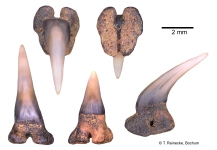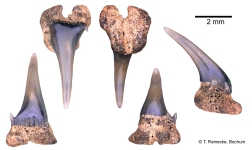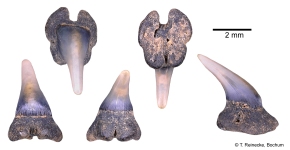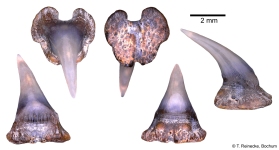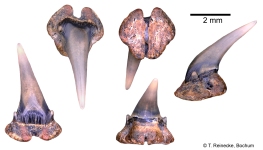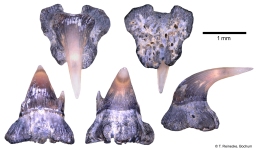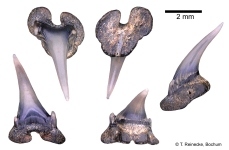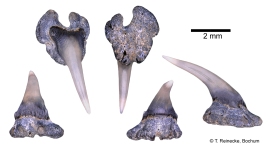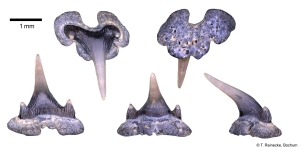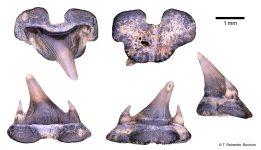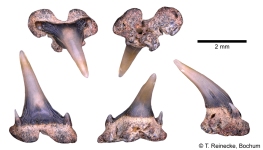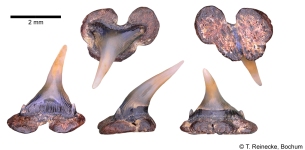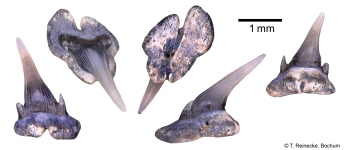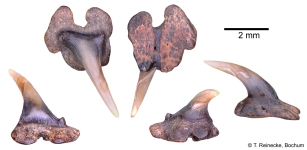Megascyliorhinus cooperi
Cappetta & Ward, 1977
Classification: Elasmobranchii Carcharhiniformes Scyliorhinidae
Reference of the original description
A new Eocene shark from the London Clay of Essex. Palaeontology, 20(1), 195–202
A new Eocene shark from the London Clay of Essex. Palaeontology, 20(1), 195–202
Description:
Citation: Megascyliorhinus cooperi Cappetta & Ward, 1977: In: Database of fossil elasmobranch teeth www.shark-references.com, World Wide Web electronic publication, Version 01/2026
Please send your images of "Megascyliorhinus cooperi" to info@shark-references.com
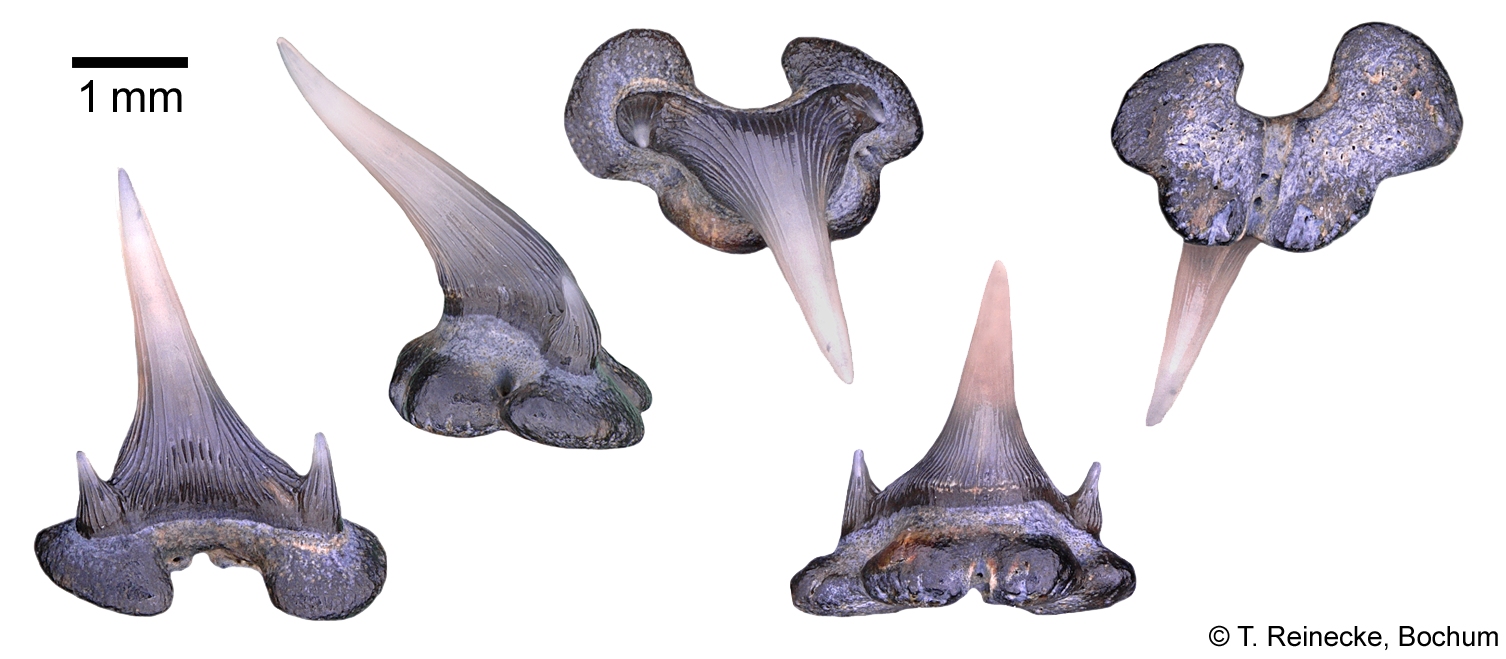
Megascyliorhinus cooperi Cappetta & Ward, 1977; London Clay Formation, Division D, Sheppey Member, Ypresian, early Eocene; Cliff Reach, Burnham-on-Crouch, UK © T. Reinecke, Bochum

Megascyliorhinus cooperi Cappetta & Ward, 1977; London Clay Formation, Division D, Sheppey Member, Ypresian, early Eocene; Cliff Reach, Burnham-on-Crouch, UK © T. Reinecke, Bochum
Description
Original diagnosis after Cappetta & Ward, 1977 p. 196 [369]: The labial surface of the anterior tooth is intlated towards the bottom of the crown and has short strong parallel striae at its base. The anterior lobes of the root are rounded and outwardly divergent. The root markedly protrudes over the base of the crown in oral view. Extreme lateral teeth have a partially closed root groove.
Original diagnosis after Cappetta & Ward, 1977 p. 196 [369]: The labial surface of the anterior tooth is intlated towards the bottom of the crown and has short strong parallel striae at its base. The anterior lobes of the root are rounded and outwardly divergent. The root markedly protrudes over the base of the crown in oral view. Extreme lateral teeth have a partially closed root groove.
Remarks
shark-references Species-ID=3609;
shark-references Species-ID=3609;
References

Faszination Haie – Die Welt der fossilen und der lebenden Haie. Der Steinkern, 58, 1–116

Fossile hajtaender fra Trelde Naes. Self-published
Combining palaeontological and neontological data shows a delayed diversification burst of carcharhiniform sharks likely mediated by environmental change. Scientific Reports, 12, Article 21906
DOI: 10.1038/s41598-022-26010-7
Feeding ecology has shaped the evolution of modern sharks. Current Biology, 31(23), 5138–5148
DOI: 10.1016/j.cub.2021.09.028

A mesopelagic selachian fauna from the middle Eocene of St. Pankraz (Austria) reveals homogeneity in deep-marine environments during the warm period in Europe. Neues Jahrbuch für Geologie und Paläontologie, Abhandlungen, 301(1), 25–63
DOI: 10.1127/njgpa/2021/0996
A study of the sharks and rays from the Lillebælt Clay (Early–Middle Eocene) of Denmark, and their palaeoecology. Bulletin of the Geological Society of Denmark, 62, 39–88
DOI: 10.37570/bgsd-2014-62-04

Neoselachians and Chimaeriformes (Chondrichthyes) from the latest Cretaceous-Paleogene of Sierra Baguales, southernmost Chile. Chronostratigraphic, paleobiogeographic and paleoenvironmental implications. Journal of South American Earth Sciences, 48, 13–30
DOI: 10.1016/j.jsames.2013.07.013

London Clay Fossils of Kent and Essex. Rochester, Kent, Medway Fossil and Mineral Society, 228 p, ISBN: 978–0–9538243–1–1

Nouvelles faunes de sélaciens (Elasmobranchii, Neoselachii) de l'Éocène des Landes (Sud-Ouest, France). Implication dans les connaissances des communautés d'eaux profondes. Palaeo Ichthyologica, 10, 1–128

London Clay Fossils of the Isle of Sheppey. Medway Lapidary and Mineral Society, ISBN 0-9538243-0-6, 100pp.

Les élasmobranches fossiles du Paléogène des Landes (Sud-Ouest, France). Implications dans la connaissance des communautés d'élasmobranches d'eaux profondes. Evolution des Squaliformes et paléoécologie. 211 p., 23 fig., annexes, 40 pl. Dipl. Doct., Univ. Montpellier II.
Relationships of the megamouth shark, Megachasma pelagios (Lamniformes: Megachasmidae), with comments on its feeding habits. In Pratt, H.L., Gruber, S.H., Taniuchi, T., editors. Elasmobranchs as living resources: advances in the biology, ecology, systematics, and the status of the fisheries: NOAA Technical Report NMFS, 90: 357–379
New records of fossil elasmobranch genera Megascyliorhinus, Centrophorus, and Dalatias (Order Selachii) in New Zealand. New Zealand Journal of Geology and Geophysics, 27(2), 203–216
DOI: 10.1080/00288306.1984.10422527

Fossil sharks, rays and chimaeroids of the English Tertiary period. Gosport Museum, 1–47, 10 fig., 3 tabl., 16 pl.

The distribution of sharks, rays and chimaeroids in the English Palaeogene. Tertiary Research, 3(1), 13–19

Faszination Haie – Die Welt der fossilen und der lebenden Haie. Der Steinkern, 58, 1–116

Fossile hajtaender fra Trelde Naes. Self-published
Combining palaeontological and neontological data shows a delayed diversification burst of carcharhiniform sharks likely mediated by environmental change. Scientific Reports, 12, Article 21906
DOI: 10.1038/s41598-022-26010-7
Feeding ecology has shaped the evolution of modern sharks. Current Biology, 31(23), 5138–5148
DOI: 10.1016/j.cub.2021.09.028

A mesopelagic selachian fauna from the middle Eocene of St. Pankraz (Austria) reveals homogeneity in deep-marine environments during the warm period in Europe. Neues Jahrbuch für Geologie und Paläontologie, Abhandlungen, 301(1), 25–63
DOI: 10.1127/njgpa/2021/0996
A study of the sharks and rays from the Lillebælt Clay (Early–Middle Eocene) of Denmark, and their palaeoecology. Bulletin of the Geological Society of Denmark, 62, 39–88
DOI: 10.37570/bgsd-2014-62-04

Neoselachians and Chimaeriformes (Chondrichthyes) from the latest Cretaceous-Paleogene of Sierra Baguales, southernmost Chile. Chronostratigraphic, paleobiogeographic and paleoenvironmental implications. Journal of South American Earth Sciences, 48, 13–30
DOI: 10.1016/j.jsames.2013.07.013

London Clay Fossils of Kent and Essex. Rochester, Kent, Medway Fossil and Mineral Society, 228 p, ISBN: 978–0–9538243–1–1

Nouvelles faunes de sélaciens (Elasmobranchii, Neoselachii) de l'Éocène des Landes (Sud-Ouest, France). Implication dans les connaissances des communautés d'eaux profondes. Palaeo Ichthyologica, 10, 1–128

London Clay Fossils of the Isle of Sheppey. Medway Lapidary and Mineral Society, ISBN 0-9538243-0-6, 100pp.

Les élasmobranches fossiles du Paléogène des Landes (Sud-Ouest, France). Implications dans la connaissance des communautés d'élasmobranches d'eaux profondes. Evolution des Squaliformes et paléoécologie. 211 p., 23 fig., annexes, 40 pl. Dipl. Doct., Univ. Montpellier II.
Relationships of the megamouth shark, Megachasma pelagios (Lamniformes: Megachasmidae), with comments on its feeding habits. In Pratt, H.L., Gruber, S.H., Taniuchi, T., editors. Elasmobranchs as living resources: advances in the biology, ecology, systematics, and the status of the fisheries: NOAA Technical Report NMFS, 90: 357–379
New records of fossil elasmobranch genera Megascyliorhinus, Centrophorus, and Dalatias (Order Selachii) in New Zealand. New Zealand Journal of Geology and Geophysics, 27(2), 203–216
DOI: 10.1080/00288306.1984.10422527

Fossil sharks, rays and chimaeroids of the English Tertiary period. Gosport Museum, 1–47, 10 fig., 3 tabl., 16 pl.

The distribution of sharks, rays and chimaeroids in the English Palaeogene. Tertiary Research, 3(1), 13–19








